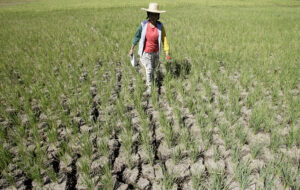Balisacan tempers economic outlook amid El Niño

— Reuters
By Luisa Maria Jacinta C. Jocson, Reporter
THE PHILIPPINES may not be able to achieve the upper end of the government’s 6.5-8% growth target next year amid global headwinds and the El Niño weather event, National Economic and Development Authority (NEDA) Secretary Arsenio M. Balisacan said.
“I would not, this early, give away the 6.5% target, but the 8% may already be out of (reach). Reducing the range is one proposal, but we’ll see once we get all the information,” Mr. Balisacan told reporters at a briefing in Ortigas on Wednesday.
The NEDA chief cited risks such as the El Niño, which is expected to persist until the second quarter of 2024 and may send food prices spiraling.
Mr. Balisacan said he will maintain the 6.5-8% gross domestic product (GDP) growth target for the medium term.
“The reality next year is all the major multilateral agencies are seeing that the global economy is not as expansive as initially expected. For us to also ignore that is not good as well. There’s no harm in reducing that 8% to some-thing lower to be realistic, but not lower the 6.5% because then you’re surrendering too early,” he added.
Mr. Balisacan said he expects growth to continue to be driven by services, particularly tourism, as it has not returned to pre-pandemic levels.
“On the demand side, the good thing about the Philippine economy is we are not so dependent on exports as a driver of economic activity. It’s largely domestic. Although of course, if we get exports growing faster… we hope exports can recover towards the second half of next year,” he added.
Easing inflation will also help support growth next year. “If we can go back to 2-4% (inflation) next year, that will rekindle robust demand,” the NEDA chief said.
However, Mr. Balisacan flagged the potential impact of the El Niño weather phenomenon on the economy.
“We are keenly aware of the persisting challenges we confront as we aim to hit such a target. Elevated inflation remains a risk because of the onset of El Niño,” he added.
Latest data from the state weather bureau showed that a strong El Niño is present in the tropical Pacific and is showing signs of further intensification in the coming months.
While the dry spell may not necessarily impact growth, Mr. Balisacan said it could stoke inflation.
“With respect to growth, the effect on the economy, I don’t think it will make a big impact. The challenge will be more on the prices. If the prices pick up, then the gains we have made in (fighting) inflation will be reversed and we don’t want that. We (don’t want to) go back to the old cycle of high inflation, high interest rates, low demand, low growth,” he said.
The agriculture sector’s growth may be at risk next year due to El Niño. However, Mr. Balisacan noted that unlike previous El Niño episodes, the country’s dams have enough water to cover the dry spell.
Mr. Balisacan also said that the share of agriculture to the economy is smaller than in previous years, limiting the impact of the weather event on GDP growth.
Agriculture typically accounts for around 10% of the economy.
Science and Technology Secretary Renato U. Solidum, Jr. said on Tuesday that 65 out of 82 provinces will likely suffer droughts until May 2024 due to El Niño.
“We are watching closely the markets. If it affects many provinces simultaneously, that could lead to an uptick in prices, that’s what we want to prepare for,” Mr. Balisacan added.
He also said the NEDA is intent on ensuring that inflation returns to the 2-4% target band next year despite the El Niño.
“We will monitor closely and use tools in government, including trade policy tools to ensure we are able to minimize the negative effects of the El Niño phenomenon,” he added.
Mr. Balisacan said that frontloading imports could be one policy tool to mitigate price pressures brought by the dry weather event.
Meanwhile, Mr. Balisacan said that the government’s 6-7% GDP growth target this year is still within reach.
“We are confident we can still reach the lower end of the target or at the very least hit a figure near the lower end of the range. We need to grow by at least 7.2% in the fourth quarter to achieve the official target,” he said.
In the first nine months, the Philippine economy expanded by 5.2%.
The NEDA chief remained optimistic that fourth-quarter GDP growth will be strong due to an increase in household spending amid the holiday season.
EL NIÑO TO DELAY EASING
Meanwhile, Fitch Ratings said the Bangko Sentral ng Pilipinas (BSP), along with other central banks in the region, could delay monetary policy easing in 2024 due to likely high food inflation caused by El Niño.
In a Dec. 13 report written by Fitch analysts Thomas Rookmaaker and Kathleen Chen, the debt watcher said Asian central banks in emerging markets may see some relief once the US Federal Reserve starts policy easing next year.
However, some emerging economies such as the Philippines, India, and Thailand are still at risk from El Niño given the large weight of key food items in the inflation basket.
“Policy responses to potential high food inflation could include delayed monetary policy easing if it affects core inflation, subsidies and protectionism, such as India’s rice export curbs,” Fitch said.
India, Thailand and Vietnam are the largest rice exporters in the world, while the Philippines is more vulnerable as food importers.
The BSP is widely expected to keep its key policy rate at a 16-year high of 6.5% on Thursday, as forecasted by 15 out of 17 analysts from a BusinessWorld poll conducted last week.
A pause on Thursday would be the second straight meeting the BSP left rates unchanged since its 25-basis-point (bp) off-cycle hike on Oct. 26.
The BSP earlier said one of the key upside risks to inflation is the impact of El Niño on domestic food prices, along with higher transport fares, electricity rates, international oil prices, as well as high-er-than-expected minimum wage adjustments.
GlobalSource Country Analyst Diwa C. Guinigundo in a note said the BSP’s risk-adjusted inflation forecasts of 6.1% for 2023, 4.4% for 2024, and 3.4% for 2025 are still unacceptable relative to the 2-4% target.
This, as forecasts for the next two years still remain “uncomfortably close to the upper end of the 2-4% official target,” even if the BSP may announce new inflation forecasts on Thursday.
Mr. Guinigundo said the public should consider the BSP’s risk-adjusted inflation forecast rather than the baseline, as it gives “a more realistic picture of what to expect” amid all potential risks.
“We expect the prolonged dry spell, or El Niño, to hit the supply side and possibly cause an upset of the downward spiral. This could be worsened by higher transport cost and power rates as well as the anticipated minimum wage increases in areas outside Metro Manila,” he said.
Even if the Monetary Board pauses at the Dec. 14 meeting, the BSP is unlikely to immediately turn dovish given the long lag of monetary policy and the numerous risks to the inflation outlook, Mr. Guinigundo said.
“A more circumspect monetary authority will choose to play it safe and keep the policy rate at 6.5% for the time being and at least maintain a steady differential vis-à-vis the US Fed’s target interest rate. A weakening of the peso is a potential outcome, and that could motivate another price upsurge,” he said.
The US Federal Reserve kept the target Fed funds rate unchanged at 5.25-5.5% at its November meeting. The US central bank has raised 525 bps from March 2022 to June 2023. — with Keisha B. Ta-asan




